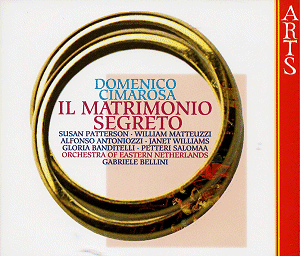Domenico Cimarosa composed
no fewer than 65 operatic works. The
first was presented in Naples in 1772.
Subsequently his works were produced
throughout Italy including Venice and
Rome. In 1789 Mozart wrote an aria for
inclusion in one of his earlier operas.
Cimarosa obtained the post of Royal
Organist in Naples in 1779 and from
1787 to 1791 he composed for the court
of Tsarina Catherine II in St. Petersburg.
Unable to stand the cold he returned
to Vienna and was appointed as court
Kapelmeister, a post coveted by Mozart.
It was in Vienna that Cimarosa composed
Il matrimonio segreto, (The secret
marriage). The second performance was
in the presence of Emperor Leopold II,
for whose Coronation Mozart had composed
La Clemenza di Tito, premiered
on September 6th 1791. So
successful were the performances of
Il matrimonio segreto that Leopold
ordered supper to be served to the cast
and the performance repeated, complete;
a unique event in the recorded history
of staged opera. The work was widely
performed in Europe during the composerís
lifetime and after. It later proved
a favourite of Verdi.
The first performance
occurred barely nine weeks after Mozartís
death, just short of his 36th
birthday. Just what it was that enabled
Cimarosa to gain the patronage, and
consequent financial security that enabled
him to compose without the strains and
stresses imposed on Mozart, can only
be conjectured. However, whilst the
works of Cimarosa cannot claim the genius
of Mozart, this opera in particular
is more than the work of a Ďroutinierí
journeyman. The opera opens with a scintillating
overture (CD 1 tr. 1) that could well
pass as minor Mozart. The plot tells
the humorous story of the rich merchant
Geronimo (bass) who wants to find aristocratic
husbands for his two daughters, Carolina
(sop) and Elisetta (sop). He doesnít
know that Carolina has already secretly
married Paolino (ten) who introduces
Count Robinson (bass) with the intention
that he seeks the hand of Elisetta.
Needless to say Robinson fancies Carolina
instead. Elisetta aided by her aunt
Fidelma (mez) complains to Geronimo
who orders Carolina to a convent. At
this point Paolino is forced to admit
their secret marriage. Geronimo takes
this philosophically whilst Count Robinson
switches his attention to Elisetta.
Fidelma is left empty-handed.
The opera comprises
a series of arias, duets and trios interspersed
and linked by recitative. Mozartian
influence is manifest in the extended
vibrant ensemble act finales involving
all the solo singers (CD 2 tr. 6 and
CD 3 tr. 13). Gabriele Bellini moves
the music along with appropriate vivacity
and the recording is clear and well
balanced. Recorded in 1991 several of
the then young singers have gone on
to significant careers. The American
Susan Patterson is fresh, agile and
steady as Carolina (CD 1 trs.2-4 and
CD 2 tr. 4). She is the soprano who
sings the heavier role of Leonora in
Chandosís recent A Masked Ball in English
. As Paolino, William Matteuzzi is flexible
and expressive and while not ideally
mellifluous has good diction (CD 2 tr
12). The high tessitura of Elisetta
is taken with aplomb and good tone by
Janet Williams (CD 3 tr. 10). Poor Fidalma,
left on the shelf despite the scheming
is strongly sung, but with a slight
edge to the tone, by Gloria Banditelli
(CD 1 tr. 10). Alfonso Antoniozzi who
sings on Opera Raraís newly issued Francesca
di Foix (review)
sings with full and incisive tone (CD
1 tr. 6). His native Italian trips off
his lips in Se fiato il corpo avete
(CD 2 tr. 8), the duet with Count Robinson.
This duet for two basses is a veritable
tour de force in this recording with
both Antoniozzi and Petteri Salomaa
singing with good firm tone and incisive
diction. Salomaa is also heard to good
effect in Count Robinsonís duet with
Elisetta (CD 3 tr. 12).
The quality of performance
and recording make this issue a strong
competitor with the starry cast DG issue
under Barenboim. To my ears that set
lacks the Italian influence, both on
the podium and among the singers that
this performance enjoys and which gives
it such vivacity. The plot is buried
in an interesting but rather diffuse
essay in the accompanying booklet. This
limitation, together with the lack of
a track-related synopsis and of track
points in the full Italian libretto,
are the only drawbacks to this enjoyable
recording. However, this Arts Music
issue provides an economical opportunity
to get to know the mature work of a
composer whose operas are far too often
compared, unfavourably, with Mozartís
mature ones. That is to compare the
great with the merely good. In my view,
Cimarosaís Il matrimono segreto can
stand alongside anything Mozart wrote
before Die Entführung. This
well sung, conducted and recorded performance,
at bargain price, will allow all opera
enthusiasts to put that view to the
test and also get to know a work that
has passed many by. It will also help
to understand why Il matrimono segreto
is one of the few 18th
century comic operas that has maintained
its place in the repertoire until the
present day.
Robert J Farr







